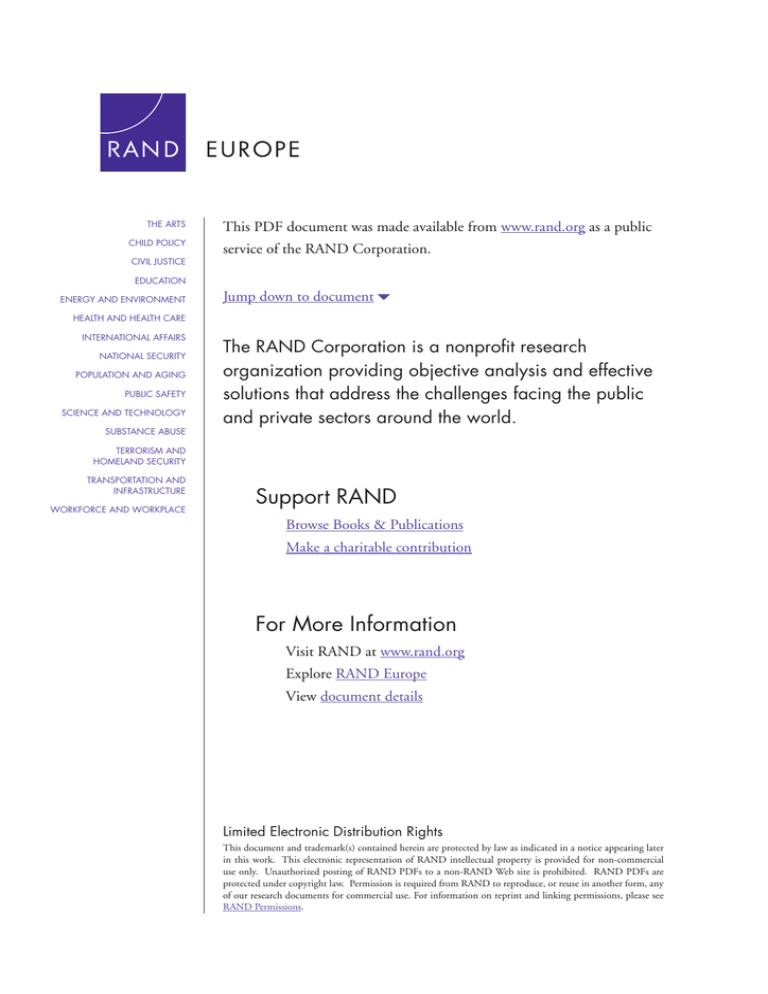
THE ARTS
CHILD POLICY
CIVIL JUSTICE
This PDF document was made available from www.rand.org as a public
service of the RAND Corporation.
EDUCATION
ENERGY AND ENVIRONMENT
Jump down to document6
HEALTH AND HEALTH CARE
INTERNATIONAL AFFAIRS
NATIONAL SECURITY
POPULATION AND AGING
PUBLIC SAFETY
SCIENCE AND TECHNOLOGY
SUBSTANCE ABUSE
The RAND Corporation is a nonprofit research
organization providing objective analysis and effective
solutions that address the challenges facing the public
and private sectors around the world.
TERRORISM AND
HOMELAND SECURITY
TRANSPORTATION AND
INFRASTRUCTURE
WORKFORCE AND WORKPLACE
Support RAND
Browse Books & Publications
Make a charitable contribution
For More Information
Visit RAND at www.rand.org
Explore RAND Europe
View document details
Limited Electronic Distribution Rights
This document and trademark(s) contained herein are protected by law as indicated in a notice appearing later
in this work. This electronic representation of RAND intellectual property is provided for non-commercial
use only. Unauthorized posting of RAND PDFs to a non-RAND Web site is prohibited. RAND PDFs are
protected under copyright law. Permission is required from RAND to reproduce, or reuse in another form, any
of our research documents for commercial use. For information on reprint and linking permissions, please see
RAND Permissions.
This product is part of the RAND Corporation documented briefing series. RAND
documented briefings are based on research briefed to a client, sponsor, or targeted audience and provide additional information on a specific topic. Although documented
briefings have been peer reviewed, they are not expected to be comprehensive and may
present preliminary findings.
Health and Medical
Research in Canada
Observatory on Health Research
Systems
Edward Nason
The research described in this report was prepared as part
of RAND Europe's Health Research System Observatory
Documented Briefing series, funded by the English Department
of Health.
The research described in this report was prepared as part of RAND Europe's Health
Research System Observatory Documented Briefing series, funded by the English
Department of Health.
The RAND Corporation is a nonprofit research organization providing objective analysis
and effective solutions that address the challenges facing the public and private sectors
around the world. RAND’s publications do not necessarily reflect the opinions of its
research clients and sponsors.
R® is a registered trademark.
© Copyright 2008 RAND Corporation
All rights reserved. No part of this book may be reproduced in any form by any electronic or
mechanical means (including photocopying, recording, or information storage and retrieval)
without permission in writing from RAND.
Published 2008 by the RAND Corporation
1776 Main Street, P.O. Box 2138, Santa Monica, CA 90407-2138
1200 South Hayes Street, Arlington, VA 22202-5050
4570 Fifth Avenue, Suite 600, Pittsburgh, PA 15213-2612
Westbrook Centre, Milton Road, Cambridge CB4 1YG, United Kingdom
RAND URL: http://www.rand.org
RAND Europe URL: http://www.rand.org/randeurope
To order RAND documents or to obtain additional information, contact
Distribution Services: Telephone: (310) 451-7002;
Fax: (310) 451-6915; Email: order@rand.org
Summary
Summary: Key Points
x Funding by endowment; providing lump sums to
research and funding from the interest on that
sum as opposed to traditional research funding
x Prevalence of higher education field in funding
research as well as performing research
x Focus on aboriginal health
x Translational activities; explicit focus on
translating research to commercial gains through
government funding
One of the most interesting aspects of the Canadian health research system is the use of
endowment funding, a system more commonly associated with university funding. The
funding of the Canadian Health Services Research Foundation (CHSRF) is mainly funded
by endowments from the major federal funders of health or services research: the then
Medical Research Council of Canada (MRCC; now the Canadian Institutes of Health
Research [CIHR]); Health Canada (the federal healthcare funder); and the Social Sciences
and Humanities Research Council (SSHRC). Between 1997 and 2002, the CHSRF has
received endowments totalling over $150 million,2 of which the endowment exclusively
controlled by CHSRF amounts to $110 million. This gives the organisation an annual
operating budget of around $16 million (the interest accrued annually on the endowment),
which is supplemented by additional federal grant funding.3 Another example of
endowment funding is the Alberta Heritage Foundation for Medical Research, who
receives endowments from the Alberta Provincial Government, and now have an
endowment fund of over $1 billion (Alberta Heritage Foundation for Medical Research,
2005).
2
CHSRF, “History: Where did CHSRF Come From?” http://www.chsrf.ca/about/history_e.php (as of March
26, 2007).
3
CHSRF, “Organizational Structure,” http://www.chsrf.ca/about/structure_e.php (as of March 26, 2007).
vii
Health and Medical Research in Canada
RAND Europe
Another interesting aspect of the Canadian system is the prevalence of the higher education
sector in the funding of health R&D; in fact, 2005 figures (Statistics Canada, 2006a)
suggest that the higher education sector spend more than the federal government, and
nearly as much as industry, on health R&D. This is partly a reporting issue based on the
use of total R&D expenditures that include indirect expenditure on research and
researchers, therefore boosting HE spend on R&D.
As with many other countries with a minority indigenous population, Canada has a
number of health problems that are specifically relevant to their aboriginal population.
CIHR have a specific institute in aboriginal health which in 2005/06 spent nearly $6.5
million on R&D for aboriginal issues. CIHR also spent an additional $12 million outside
of the funding from the aboriginal institute (CIHR, Institute of Aboriginal Peoples’
Health, 2006). Politically, there is great importance attached to the issues faced by
aboriginal population.
Also of note is the emphasis on translation that is evident in the government-funded sector
of the health research system, in which CIHR has several specific programmes to foster
translation to practice and economic benefit. CIHR also participates in the Networks of
Centres of Excellence (NCE) programme that aims to improve research and translation
through extensive virtual networks of academic researchers, industry, government, and
hospitals.
viii





